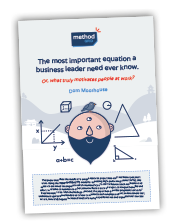THE equation - Unlocking E - The Zen of entrepreneurship - Why MBAs don’t help - What life is all about - The Three Es
Last week, I left you with a teaser. I promised to reveal the most important equation a business leader need ever know. This was partly a deliberate tease; that is, part in copy-writing flourish. That said, I state this with a genuine and very-serious edge. I truly mean it when I say: that this blog will reveal the most important equation a business leader need ever know. An equation that gets to the absolute nub of what motivates employees. Before we get into the what, the why and the implications of all of this, let’s cut to the chase. If you are involved in leading others at work (be that a small start-up team or a major organisation), make an indelible note of this now:

This blog (along with the accompanying FREE paper) will reveal: how it was derived from a significant research project, what it all means, why it is crucial to your organisational success and, most importantly, how you can use it – at a very practical level – to unlock massive business value in your own venture.
What motivates employees?
Let’s start with the domain the equation pertains to. The dependent variable (E) concerns employee motivation and effort.
On the right-hand side of the equation are the independent variables: IS, Y and Z that truly drive E. The paper describes these three critical aspects in detail including their relative contribution to E. The paper will also, by the corollary of absence, reveal what doesn’t impact on E: in direct contrast to dominant, lazy supposition and lingering, historical theory.
Why is this important?
Well, if you have any professional concern whatsoever with respect to business or organisational performance you should, de facto, be concerned with optimising team member performance. Manifestly, team member motivation and effort (E) has a major contributory role to play in driving performance. If you follow this simple logic train then I have, hopefully, convinced you as to the massive domain relevance of this equation. Simply put: for the clear majority of ventures (certainly all those with people involved!) results hinge largely on employee performance which, in turn, hinges heavily on employee motivation and effort (E). Unlock E and you unlock the full potential of your venture.
Please send me
The most important equation a business leader need ever know
Or, what truly motivates people at work?

Before we continue, let me allay some early reader misperception or concern. Understanding employee performance, employee motivation and how to maximise such matters is a grubby, real-world concern not easily transduced into abbreviations and formulas. The motivation of others is not something that happens in some sterile laboratory under the gaze and direction of earnest academics. So, for now, please just be assuaged by the fact that I am – first and foremost – a practitioner. The formula, and the research behind it, is genuinely fascinating to know but only as a stepping off point into its real-world implications. My personal career experiences include an eight-year Officer Commission with Her Majesty’s Royal Marines, entrepreneurial leadership of a management consulting business (from singleton start-up to £20m valuation in five-years) and strategic, advisory support to hundreds of professional service companies. As such, the paper will explain the formula to you but – once this is done – it quickly draws the reader towards all the pragmatic “so what” implications – based on my own grounded professional experience.
How this all come about …
I have long been fascinated by the topic of high-performing teams especially as it pertains to the real-world, coal-face, cut-and-thrust of business and organisational life – as opposed to an academic dalliance.
Largely without appreciating it (certainly not at the time), I absorbed a huge amount of what practical excellence looks (and feels!) like during my twenties serving in Her Majesty’s Royal Marines. The Officer training programme – every gruelling moment of its fifteen-months – is arguably one of the finest leadership academy experiences in the world. Being a member of such a fine military corps for the best part of a decade meant I was surrounded by excellence in this respect: with so much to learn from so many talented leaders and colleagues, along with all the best practices passed down through 350 years of proud tradition. With reflection, by process of idea-osmosis (if not conscious development), I learnt what team-centric excellence looks like; in other words, I had developed a firm mental reference point established as to what good looks like. It should be emphasised that this reference point was as relevant to business as it was to elite military endeavour.
Again, more by natural extension than any stated, conscious effort such practices imbued how I went about building my own business. The way I went about developing the team at (eponymously-named) Moorhouse was not taken from any textbook, any external advisor, but rather from everything I felt to be intuitively right: based on such prior experience. Everyone does it this way, I presumed.
What that team executed was stellar. In less than five years from my singleton conception we were one of the most respected consulting organisations in the UK: supporting premier multi-national client companies with their most complex transformative challenges. Aside from manifest commercial ascendancy – growing to a £20m valuation business in less than five-years – the real heart of this story concerns what it felt like to be a part of that journey. Repeating my Royal Marines experience, I stood again within a group of extremely talented others. A collective that (deservedly) believed any professional challenge was surmountable in union (without suffering from any associated hubris). A collective whose company I loved: never a dull day, always some banter and humour to traverse the more mundane moments of corporate affairs. In short, my primary thought looking back on this phase of my career is one of unbelievable privilege. My abiding contemplation is of a very human, philosophical nature: the real gain from such journeyship being an inner, emotive one. Aside from all the professional, financial, status-laden totems of such success, the most important carry-forward is the most intangible. When I look back at the experience, with some pride, I simply smile.
So, to my core and at a very practical level, my early career showed to me that not only do teams matter in terms of bringing about the plans and goals you seek, but being part of one is, in final analysis, what gives human substance to our lives.

It never really occurred to me just quite how unique these formative team-membership experiences were until I started the current phase of my career: advising and supporting others in the development of their entrepreneurial ventures. A hefty component of my time was now spent talking with business leaders and advising them on what motivates employees to build great professional service brands. With the myriad, resultant insights into other companies, and in reflection of the countless conversations with such leadership teams, I observed a clear pattern. Whilst they nearly all had sound strategies and, indeed, well-formed plans (as you would expect from intelligent business seniors), there was a clear demarcation between those companies that made material progress and those that just meandered along. This was not a symmetrical split either; when the rubber hits the road and execution of plans is what it is all about, the clear majority fall. “How is it possible …”, struggling leaders ask me, “… to meaningfully progress plans when my colleagues have such busy day-job demands placed upon them?”. With increasing clarity, I realised that success hinges on the presence of a high-performing team … in a leader’s deep understanding of what motivates employees. Having ambitious, coherently-structured growth plans is one thing but building such a team to actually execute them is where it all truly lives or dies!
Put another way, I realised I had fallen slowly in step to the drumbeat of modern management theory. As fuelled by MBA schooling, we have become conditioned to drool over the clever-clever, young entrepreneur who smashed their way to success with the idea – the business model that completely turned a staid market on its head. We train up-and-coming leaders to think strategically – to analyse, data-crunch, to find the opportunist gap that outsmarts the competition. All of this is, self- evidently, very important. The idea, and the strategy is not, however, the place where the centre mass of success truly lies. There are myriad brilliant ideas, with sound stratagems behind them, scattered to the graveyard of failed endeavour. There is, conversely, a heap (probably the majority) of very, very successful businesses where success hailed not from the idea, not from the strategy, as sound and sensible as they both were, but from the ruthless efficiency in which a team gathered around the resultant plan and executed it.
In simple terms, I came to learn that observed success fell to those who got team and execution first, ideas and strategy: a close second. Indeed, I had arrived at an axiomatic truth: your ultimate personal/entrepreneurial/ professional success hinges not on your personal technical smarts and prowess, your idea or your strategy; it hinges on whether you can build a high-performing team around you. Success in business, and many other aspects of life, is all about execution, execution, execution. Yes, you need a sound idea, a robust strategy but what takes you from a pub-conversationalist to actual real-world success is this ability to execute. And, the ability to execute is all about high-performing teams.
That all, hopefully, explains my fascination with the team topic and why my interest grew to not only a more considered observation of practice but an intellectual interest also. My professional library started to fill with books on the subject: from ten-a-penny, journalistic, perishable flimsies to micro-economic papers (it is, after all, oft argued that economics is as much a study of human behaviour as it is a study of money).
The journey into this specific research was fed by a deep curiosity, specifically as concerns the question: what motivates employees at work? What was discovered with the ensuing study, whilst aligning with some originating intuitions, was startling. And, to repeat: these findings will be of material significance to anyone involved in the leadership of others!
The write-up of these findings – and the practical “top tip” suggestions for all ambitious professional service firm leaders now fills a 53 page paper that you access for FREE when you sign-up to this weekly blog.
Please send me
The most important equation a business leader need ever know
Or, what truly motivates people at work?

So, what’s next?
Next up in the series, I am going to spell out what makes professional service companies so unique from other ventures – and the implications of these differences for all entrepreneurs and leaders seeking to build such companies.
Hopefully, you’ll join us on this journey. It’s totally free, and you don’t have to be a Method Grid customer (though you’re more than welcome to sign up for a free trial here).
We’ll be releasing a new post each week, starting with the one outlined above. To get each post emailed to you as soon as it’s published, sign up for the Climbing Mount Audacity mailing list below.
Climbing Mount Audacity…
From Startup to Scaleup!
We're sharing everything we know about how to build an awesome professional service firm (and enjoy the journey en route!) PLUS travel updates, reflections on our stumbles and general musings on our Method Grid journey.
Signup below to get the latest articles
direct to your inbox.
See you next week. Have something you want to hear more about? Let me know in the comments below or via Twitter.

 Project and Program Management
Project and Program Management  Project Governance Framework
Project Governance Framework  Benefits Management Framework
Benefits Management Framework 







Great post.
There doesn’t have to be a perfect plan, just a strongly-woven team who believe it be perfect. That’s where the perfection lies.
Just downloaded the paper for some light reading this weekend.
Thanks very much!
Thanks Felix. Plan perfection in the eye of the plan beholder. I don’t disagree. Thanks for taking time to feedback. I would love to hear further thoughts when you have had time to read.
Hi Dom,
I finished reading your paper this weekend and found it extremely insightful.
Firstly, your Team-to-Tribe (T3) model really peaked my interest, especially as your research suggests that membership of a HFP is the most significant factor in maximising employee motivation and effort!
The position of W and X in your equation also makes much sense.
Thank you very much for the targeted questions to aid in the pursuit of stepping up the T3 ladder.
Now reading your paper “The Role of Values in High-Performing Team” for additional insight.
You’ve given me much to think about.
Looking forward to action.
Roll on 2018.
Thanks again.
All the best
Thanks for feedback Felix. Wishing you all the best for those team plans in 2018!
Hi Dom
As a facilitator who tries to get the best out of individuals and teams I would be fascinated to read your paper. Many thanks. Simon
Simon. Thanks for kind words. In turn, I would be fascinated to hear your professional opinion on the results of this research as/when you have had time to read.